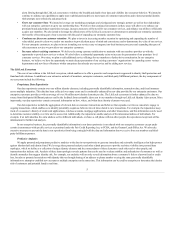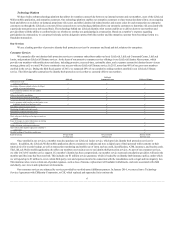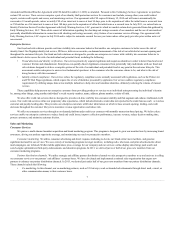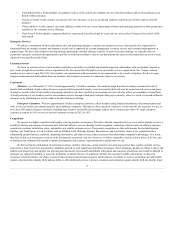LifeLock 2013 Annual Report Download - page 18
Download and view the complete annual report
Please find page 18 of the 2013 LifeLock annual report below. You can navigate through the pages in the report by either clicking on the pages listed below, or by using the keyword search tool below to find specific information within the annual report.
growth in mobile devices, there is no guarantee that we will be able to effectively monetize our mobile application and generate meaningful revenue in the
future. If our mobile application is not widely adopted or sufficiently profitable, or if we fail to continue to innovate and introduce enhanced mobile
applications and other services for users of these alternative devices, our business could be adversely affected.
As new devices, platforms, and technologies are continually being released, it is difficult to predict the problems we may encounter in developing
versions of our services for use with those devices, platforms, and technologies, and we may need to devote significant resources to the creati on, support, and
maintenance of such offerings. We are dependent on the interoperability of our mobile application with popular mobile operating systems that we do not
control, such as Android and iOS, and any changes in such systems that degrade our application’s functionality or give preferential treatment to competitive
products could adversely affect usage of our mobile application. Additionally, if we are slow to develop new services and technologies that are compatible with
these devices, platforms, and technologies, or if our competitors are able to achieve those results more quickly than us, we will fail to capture a significant
share of an increasingly important portion of the market for online services, which could adversely affect our business.
Our revenue and operating results depend significantly on our ability to retain our existing customers. In our consumer business from which we derive
a significant majority of our revenue, we sell our services to our members on a monthly or annual subscription basis. Our members may cancel their
membership with us at any time without penalty. In our enterprise business, our customers have no obligation to renew their agreements with us after the
contractual term expires, and approximately half of our direct enterprise customers do not have monthly transaction minimums and, accordingly, may reduce
their utilization of our services during the contractual term. We therefore may be unable to retain our existing members and enterprise customers on the same or
on more profitable terms, if at all, and may generate lower revenue as a result of less utilization of our services by our enterprise customers. In addition, we
may not be able to predict or anticipate accurately future trends in customer retention or enterprise customer utilization or effectively respond to such trends.
Our customer retention rates and enterprise customer utilization may decline or fluctuate due to a variety of factors, including the following:
•our customers’ levels of satisfaction or dissatisfaction with our services;
•the quality, breadth, and prices of our services;
•our general reputation and events impacting that reputation;
•the services and related pricing offered by our competitors;
•our customer service and responsiveness to any customer complaints;
•customer dissatisfaction if they do not receive the full benefit of our services due to their failure to provide all relevant data;
•customer dissatisfaction with the methods or extent of our remediation services;
•our guarantee may not meet our customers’ expectations; and
•changes in our target customers’ spending levels as a result of general economic conditions or other factors.
If we do not retain our existing customers, our revenue may grow more slowly than expected or decline, and our operating results and gross margins will
be harmed. In addition, our business and operating results may be harmed if we are unable to increase our retention rates.
We also must continually add new customers both to replace customers who cancel or elect not to renew their agreements with us and to grow our
business beyond our current customer base. If we are unable to attract new customers in numbers greater than the percentage of customers who cancel or elect
not to renew their agreements with us, which we call “churn,” o ur customer base will decrease, and our business, operating results, and financial condition
will be adversely affected. Churn negatively impacts the predictability of our subscription revenue model and the efficacy and attractiveness of the LifeLock
ecosystem by decreasing the amount of data being added to our data repositories.
We have derived, and intend to continue to derive, a significant portion of our revenue from members who subscribe to our consumer services through
one of our strategic partners. In 2013, we derived just under half of our gross new members from our strategic partner distribution channels. These
distribution channels involve various risks, including the following:
•we may be unable to maintain or secure favorable relationships with strategic partners;
•our strategic partners may not be successful in expanding our membership base;
•our strategic partners may seek to renegotiate the economic terms of our relationships;
•our strategic partners may terminate their relationships with us;
15
























